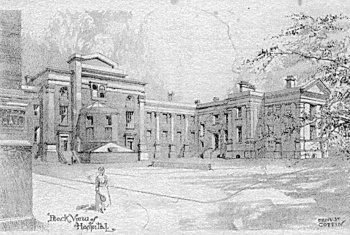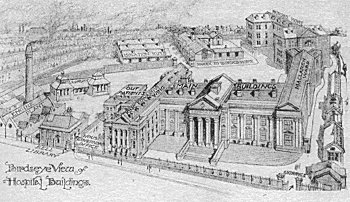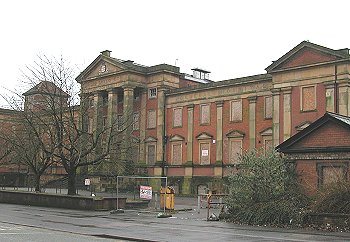|

|
In the mid eighteen forties, in essence prior to Nightingale, a group
of Victorian philanthropic businessmen in Wolverhampton were determined
that the town was worthy of a hospital as an alternative to a six bedded
dispensary.
Duty was done and a total of some £18,000 was raised which purchased
land from the Duke of Cleveland, and a fine portico fronted hospital
with 84 beds was built with the residual £14,000 plus.
|
|

A late 1920s view of the hospital. |
The hospital opened its doors in January Ist 1849
to "patients who are such unable to pay for medicine and advice
and are destitute of funds to make provision for them". It was
run by a non-stipend Board of Governors and was totally reliant
for its complete running costs on charity. |
| By the turn of the century, the hospital was
recognised for training doctors and nurses and had established a
pathological laboratory (albeit in a shed), a steam laundry,
medical library, hospital chaplaincy, electricity and a new
kitchen. By the year 1912 the hospital had developed a 53 bed
nurses home, a new wing of beds dedicated to King Edward VII,
its own motorised ambulance provided by Wolverhampton Police
Force, an electric lift and a new laboratory. |
| During the First World War, much use of its
facilities was made for the war wounded from France. Lady
doctors were used for the first time, and many of the staff
themselves gave war service. In the ten years immediately after
the Great War the hospital added many new departments and wards,
including operating theatres and VD clinics. The hospital was
visited by the Prince of Wales and granted its Royal Charter. By
1928 it became known as the Royal Hospital, losing one of its
former names of Wolverhampton and Staffordshire Hospital. |

A postcard from a series printed in the
1920s to raise funds for the hospital. Courtesy of Neil Fox. |
| During the nineteen thirties, the Royal Hospital
acquired the reputation of being one of the best provincial
non-teaching hospitals in the country. This was largely due to
the work of three men - J.H. Sheldon, R. Milnes Walker and S.C.
Dyke.
Sheldon came to Wolverhampton from Kings College Hospital
after the first world war and was a pioneer of the 'brains
drain' from the teaching hospitals to the provinces which began
to raise the standards from largely G.P. part time hospital
staff to consultant- led institutions. He gained national
recognition in 1986 when he published a monograph on
haemochromatosis based on his own observations - a work still
referred to in the literature. His clinical reputation was
enhanced by a classic account of an outbreak of trichomaniasis
during the second world war. Soon after the war he produced his
important report on the medicine of old age. He used to say that
one of the most valuable services for the elderly was the
marketing by Woolworths Stores of simple convex lens spectacles.
At that time nothing in the store cost more than 6d (2.1/2p), so
that many elderly people were able to read again. This work was
an important factor in the formation of the new speciality of
geriatric medicine, and for some years Sheldon became a leading
authority on the subject. |

Another postcard from the series printed
in the 1920s to raise funds for the hospital. Courtesy of Neil
Fox. |
Milnes Walker acquired a considerable reputation
as a surgeon and attracted patients from a wide area. He had a
large family and became so busy that his home life was severely
affected. Shortly after the war, his talents won him the post of
Professor of Surgery at Bristol, so sadly, Wolverhampton lost
him. |
| Dyke also came to Wolverhampton from a London
teaching hospital in the early 30's. He was an excellent
histologist and had the quality of admitting when he did not
know. He developed an interest in diabetes and was one of the
first to use insulin. As late as the early sixties he used to
demonstrate a patient still in good health who was said to be
the fourth subject in the country to have been given insulin.
His diabetic clinic was huge and he used to sit at a desk raised
on a small platform while the patients filed past him, as there
was still little space for waiting in the laboratory; it was a
familiar sight to see a queue of people with raised umbrellas
outside the laboratory door. He was involved in the trials of
the antibiotic "M & B 693" before the discovery of penicillin.
He had something of a flair for showmanship and formed the
European Association of Pathology.
With such well known figures in a provincial hospital, it is
hardly surprising that bright young men were attracted as
residents, and when the bombardment of London began in 1940 and
the city's medical schools were moved out of danger, the
Middlesex Hospital sent students to the Royal Hospital. Some of
these, delighted at their experiences, returned after
qualification as residents and later settled in the town as
consultants and G.Ps. |
| In the late thirties a complete new wing of five
floors containing 120 beds and a fine swimming pool was added.
By the forties the hospital had developed into an excellent
general hospital encompassing all the necessary medical
specialities and facilities, including cancer treatments. During
the Second World War it again received many war wounded. In 1948
it was handed over to the NHS with its books in the black and
having been developed and run for 100 years on the charity and
zeal of Wolverhampton's businessmen and worthy citizens. |

The hospital building as it is today. |
| During the fifties, in addition to its excellent
male and female Nurse Training School of some distinction, it
established both Physiotherapy and Radiography Schools of
similar note. Its quality of care and training of staff became
legion throughout the UK with increasing numbers of overseas
medical, nursing and physiotherapy students arriving. In the
early fifties a Nurses League, Hospital Friends and Nurses
Christian Movement was established. Considerable improvements to
patient services were seen, and a new kitchen was built. |
|

The hospital buildings in 2003. |
Throughout the sixties and seventies a new theatre
suite and I.T.U. facility, plus a coronary care unit were
established; however talk had begun to move the hospital’s
facilities to the out of town New Cross Hospital site of some 60
acres, albeit a former workhouse. |
| This decision was finally enacted, and the Royal Hospital
closed on Tuesday 24th June 1997 after more than 148 years of
care and dedication to the citizens of Wolverhampton, thus
ending a centre of excellence in the epicentre of Wolverhampton
Millennium City. |
 |
Return to
the
health section |
|